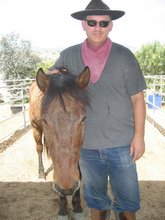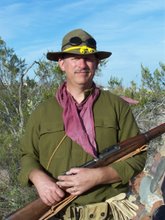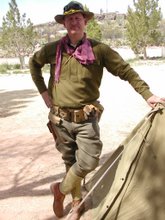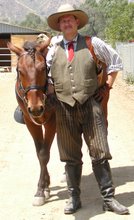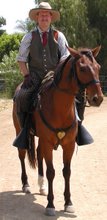Tuesday, January 27, 2009
At the Movies: 1612
At the Movies: Taras Bulba
Monday, January 26, 2009
Superpowers at War (Cont.)
It's been a brutal grind for NATO but their line is still intact although I haven't really found an opportunity for an effective counter-attack yet. At the same time, the Soviet advance is finding itself funned into the center, away from the Southern flank due to the rough terrain extending towards Liege. If the Soviets are going to take Liege, it's going to have to be in flanking movement from the center.
I'm beginning to get the hang of the combat chart and the initiative process- with the use of the initiative points and lucky die rolls, either side and deliver a hammering blow if done right. The trick is working out the right method.
More later.
Sunday, January 25, 2009
Sunday Sunday...
By the time I'd arrived at the stables, there was mixed cloud cover and it looked pretty ugly towards the mountains. However, while it was muddy, it wasn't raining so I decided it was a good opportunity to get in some saddle time. After saddling and tacking up Max (and cleaning all the dried mud off of him!), two friends of mine had also shown up at the stables and we decided to go on a ride around the lake in the Hansen Dam Basin.
The weather was actually pretty nice with mixed clouds and sunglight and we proceeded to start our along the base of Hansem Dam. Eventually we made our way towards the park where we eventually encountered people- especially people on bikes.
Unfortunately, I haven't put in a lot of work in this area so Max was definately in fear of the bikes and at several instances I had to struggle to keep him focused on me and not on the bike.
Other than the bikes, there weren't any issues and after about two and a half hours we finally got back to the stables. Contrary to my prediction of rain, it was actually pretty sunny and it warmed up a bit.
After giving Max a break, I decided to start getting Max desensitized to bikes so I put him in the arena and then walked in with a bike. Max was pretty good about coming up to the bike and sniffing it when it was stationary (although you could hear him snort). However, when I moved the bike, he'd back away. I basically spend about 20 minutes riding and walking the bike around the arena. Maz would stop, look at me, and then trot off if I got too close. Riding the bike was a bit diffcult because of the uneven surface and mud in the arena.
I'm going to have to be patient about this but I'm confident that eventually I can work him over his fears of bikes. It's just going to take some time.
Saturday, January 24, 2009
Riding in the Rain
I figured that until the rain started pouring down, everything seemed to be a go so I made my way over to the stables about 7:30 am. I soon had Max cleaned up (as best as I could),saddled and tacked and was ready to go by about 8:15 or so. I think rode over to the arena at Gabriellano Park to get ready for Warhorse practice.
After a few phone calls, I determined that Warhorse practice was definately on so I begain to warm Max up. The arena was a but soggy with standing water in a few places but overall, the footing seemed to be fine. I then proceeded to work Max on transitions, starting with walk/halt, trot/halt and finally canter halt. It was a bit difficult getting Max's full attention, no doubt because of the mud and mist (he was energenic though). However, after awhile, Max fell into the groove and we were doing pretty good. We also worked on side passing and various trainsitions and collection- especially canter collection (which is not easy for Max- he's basically building muscles)
Practice went well and Max made an effort to cooperate and he's slowly learning that he's part of a "herd" rather than an individual horse. Definately a good thing! :-) As the practice went on, it began to become very misty and the horses seemed to like it and become more energenic. Finally, after about two hours, we cooled the horses down (you could see steam coming off their manes and hanches) and proceeded home. At this point, the mist turned into full-blown rain so after taking Max home and getting him secured, I celebrated a successful practice with a couple of shots of Port.
From hot Santa Ana winds to mist and rain in a week- only in California, it seems. :-)
Friday, January 23, 2009
Superpowers at War (Cont.)
The Soviets were especially able to make headway when they rolled favorably for initiative in the Second phase and were basically able to take two moves, back-to-back. This allowed the Soviets to create a series of pockets and further dislocate the NATO defenses. At present, elements of the French III Corps are rushing to reinforce the center of the NATO defenses while the Dutch 304th Territorial Brigade is setting up a back-up defense line in front of Venlo.
So far, NATO had held off landing elements of the 82nd Airborne Division and the Blegian Speciail Forces Brigade. The Soviets have held off dropping the 103rd Airborne Division due to not having air superority. Interesting enough, airpower really hasn't helped one side or the other in this game nor have chemical attacks.
More soon.
Wednesday, January 21, 2009
More Vasquez Rocks Stuff
ETI Corral 20 Vasquez Rock Ride
Widget powered by EveryTrail: GPS GeotaggingTuesday, January 20, 2009
Superpowers at War (Cont.)
Played out Game Turn Two over the weekend. Initiative was determined and NATO, fortunately, came out the winner for the first phase and proceeded to fall back to form a new line. For the most part, the Soviets managed to breach the Rhine defenses at several points, forcusing on areas that lacking urban/city hexes. The Soviets were able to isolate Bonn but the West German forces were able to retreat taking advantage of the rule that ZOCs don't extend into city/urban hexes nor accross rivers.
The replacement rules do some distance in remedying the bloody CRT although the rules are unclear as to where they enter. I interepreted them allow replacement units to enter wherever there was a unit (in supply) of their respective army.
Thank god for the Belgian Territorials- they were able to provide a backstop along the wooded/rough area just west of Bonn. NATO was able to get air superiority so were able to transport in the remainder of the 1st Cavalry Division and the division was able to take up positions to the north, just west fo of the Rhine. The one big problem was that I lacked enough units to take advantage of anchoring the NATO line on the major city/urban complexes just west of the Rhine, towards the north end of the board because you would need a unit to occupy each hex since ZOCs don't extend in. So the alternative was placing some units in not-so-optimal terrain. The 82nd Airborne and Belgian Special Forces units were retained off board as a reserve.
The Soviets came surging forward and now that they were able to shake out and fully deploy, were able to blow some large holes in the NATO defences. Because of the lack of air superiority, the 103rd Airbone Division was retained off-board. Lucky for NATO, they rolled high for initiative in the second phase and were able to patch together another line. The Dutch 304th Territorial Brigade was then shifted north towards Venlo to backstop the northern flank since the Belgians too some heavy losses in that area.
Impression so far. Not quite a cakewalk for the Soviets but it's only Game Turn 2 and they're making some good progress. Hopefully the arrival of the French III Corps will help slow things down.
Game Impression: Not a broken game by any means but definately was not fully developed as it should have been. More soon.
Sunday, January 18, 2009
Back to Vasquez Rocks with Max
We left the stables pretty early and arrived at Vasquez Rocks a little bit after 8am, the official opening time. Max was a bit wound up when I unloaded him from the trailer (no issues loading, thank god!) but soon calmed down. It was intermittantly windy and warm- roughly 70 degrees and it warmed up was the day progressed. I soon had Max saddled and ready go and while waiting, I made Max perform a number of dessage manuevers to take his mind off of the new environment. Max seemed to calm down and start paying attention to me. With the wind and other horses, Max was naturally a bit more excited than if it had been just me with no wind blowing. Factors to consider.

There was roughly 20 riders and we left the assembly area at about 9 am and began to make our way down a series of trails that would ultimately take us in a loop. Some of the trails had changed due to erosion and such so at several points we had to backtrack and find new trails. It was a bit nerve-racking stopping on an uphill or downhill because Max would begin to get nervious- I don't think any of the horses liked that situation so max wasn't the only one.
Unlike the last group ride I took last August at Morro Bay, Max was fairly well behaved and when he'd start to get jiggy or agitated, I used half-halts, collection, and occassional sawing of the reins to bring him back. The key, I think, is to not jam hard on the bit and lock it there. In that past I think this was contributing to my problems with Max with him getting buzzed up and excited. Also, I sought to constantly relax myself and breath deep. Also key was that I used both reins. This seems to give me better technical control and I'm able to excercise much finer control on his mouth and perform better half-halts. Overall, the goal was to keep focusing his mind on me rather than the situation.
The wind was extreme at some points and we really got hit when we'd ride along a ridge. Also, an inteesting thing is that there's a tunnel that runs underneath the 14 Freeway that connects with other horse trails so you can ride further out. I wasn't daring enough to ride the tunnel so I waited along with some of the other riders while a few tried it out. I think the next time I'll check out the tunnel. It's pretty wide and has a lot more light (at least given it was a clear day around 11 am) than the one running under Wentworth Street back home.
One sticky part was when we began to descend down one trail that turned out to be too steep to safely descend. We had to basically turn around and backtrack up the hill we were coming down from. I managed to get Max to turn around on his haunches with no problem but it definately got the blood pumping. Max was quick to act and I think he figured that we were going to turn around- it took very little prompting.
We finally made it back to the assembly area by Noon and soon after we were ready to go home. Max did his usual refusal to get in the trailer but then complied after I growled at him (thank god!). Overall it was a nice ride and definately a good training opportunity for Max. Things appear to be getting a bit better for Max in group situations so I hope there's more improvement.

Saturday, January 17, 2009
Max's Saturday Practice
During the week, I practiced sidepassing for several days, mixed in with a lot of other manuevers (primarily transitions). I would do only a few at a time and in each instance only have Max move one or two steps and then come to a complete halt. We'd pause and the move another one or two steps (it seems like taking two steps is a bit easier). The thing is to not rush it and to instill in Max the idea that it's not something to be rushed through at speed. Also, it's essential to balance one's seat and to not "ride the horse" by putting tension on the reins and tightening up your muscles. It's basically like you have to be firm, but not too firm and it can vary from day-to-day and moment-to-moment, depending on the horse (what sort of a "day" they're having).
Max passed this part with flying color this time and he didn't have any issues. It also helped that my riding was a bit more relaxed and I made very effort to collect Max and focus his attention on my rather than the environment around him. Also, we practiced cantering in line, starting with groups of two riders and then building up to 4 and 8 riders in line. It was very interesting and my practice with transitions and collection paid off here as I had to rate Max's speed and especially in going around corners (we were doing canters in a wide circle.
What was even more interesting was that it becomes more difficult to do a controlled canter in a longer line than in a shorter line. Max normally does better on the inside of any circle because he's a slow horse but while cantering in a line 8 riders abreast, I literraly had to bring him down to a walk (Max was the inside horse) while going through most of the turn and then speed up to match the outside horses' speed when opening into the straightaway.
I was pretty amazed at the results.
Also, my transition work paid off in brining Max through his various manuevers where we would alternatively have to speed up into a trot or canter and then slow to a walk. You could get away with using only the reins and bit but it's very crude and hard on the horse's mouth. The most effective way is through transitions and collection (and especially using breath control to communicate with the horse). Reins have a place but they're used more as a means of maintaining contact with the mouth just enough to let the horse know that you're "there".
It's all very interesting stuff and it's taken my riding to a whole new level- all that "dressage stuff" :-) that my friends used to give me trouble about. :-)
Thursday, January 15, 2009
Superpowers at War (Cont.)
Because of the iniative rules for the "Accross the Rhine" scenario, NATO got to move first, which is a good thing. With the on-board German territorials, I set up a cordon to block off "Entry Area B" in the North, keeping to the mandated two-hex distance and using the urban hexes as bastions.
To the south, I was able to deploy more territorials along with the 21st Panzer Brigade (I received the 21st, along with some 7th Panzer Division divisional elements and the British 15th Brigade as variable reinforcements), entering from the east, to form a cordon to block "Entry Area A". The center of the German defense is the Rhine, combined with using urban hexes (Bonn is especially good). Because of the entry rules, the slower territorials had to deploy closest to the entering Soviet units.
The Belgians spend the turn racing towards the front while I kept the Dutch 304th Territorial Brigade close to Maaschrict to counter any Soviet airborne drops. I also kept the 82 Airborne and Belgian Special Forcs units off the board as a reserve (especially since air superority was undecided). The US lost one artillery batallion of the 1st Cavalry Division when the die roll went wrong on air transport (presumed that the transports were shot down by stray Soviet fighters).
Because of the using urban hexes as defensive positions, the Soviets were unable to use overrun as they entered the board so they had to set up their attacks. The Soviets decided to hold back on dropping the 103rd Airborne Division pending a better result on the air superority table. Nothing disastrous occurred for NATO although they lost two batallions of territorials. I anticipate that the front is going to blow wide open next turn.
So far, the things that stick out are that while the combat system attempts to blend morale into the combat results, it's a real pain to calculate the combat factors. A better job could have been done integrating all the elements- you have to remember to not only check the terrain table for combat effects, but you also have remember that all firepower is halved in the second movement/combat phase and armor and infantry can further be affected by terrain. All good ideas but the execution is clunky.
What is also interesting is that combat is calculated by adding up "firepower" of the ground units- no real discrimination is made between artillery and ground. Airpower can add more firepower points and chemical munititions force a collum shift on the combat chart. The firepower total can be affected by terrain (urban hexes, for example halve the total) and then once again if it's the second phase. Firepower can drastically go down.
I've still got to get a handle on the combat chart but results are possible at low odds (as well as adverse results).
Overall, some interesting ideas are here and it's a bit easier to play than say the Central Front series. However, calculating combat is a bit fiddly and the whole airpower/tranpsort rule section just doesn't seem to mesh well. OK, these are initial impressions, that can change.
More soon!
Monday, January 12, 2009
Superpowers at War

I came accross this game while doing some New Year's Clean-up: Superpowers at War. This was originally published in S&T No. 100 (during the dark years when TSR was publishing it). It's an interesting system but I haven't gotten too far into it. The one bad part is is that the proofreading on the rules is poor and some areas are almost impossible to figure out without the errata (thank you Web Groganards!). It also doesn't help that the counters for one scenario are back-printed on the others- I realize it was a cost-saving measure but please. And the microscopic TSR printing on the counters...anyway, I'm going to give this one a try.
I'm currently playing the "Accross the Rhine" scenario where the Soviets are attempting to cross the Rhine and drive into the Netherlands and Belgium.
When I've played some, I'll post more commentary.
Friday, January 9, 2009
Machu Picchu

I've always wanted to visit Machu Picchu, the "Lost City of the Incas" since I was a little kid ever since I first saw breat-taking pictures of the City such as the one above. Here's some detail, courtesy of Wikipedia:
Machu Picchu (Quechua: Machu Pikchu, "Old Peak"; is a pre-Columbian Inca site located 2,430 metres (8,000 ft) above sea level. It is situated on a mountain ridge above the Urubamba Valley in Peru, which is 80 kilometres (50 mi) northwest of Cusco and through which the Urubamba River flows. The river is a partially navigable headwater of the Amazon River. Often referred to as "The Lost City of the Incas", Machu Picchu is one of the most familiar symbols of the Inca Empire.

It was built around the year 1460, but was abandoned as an official site for the Inca rulers a hundred years later, at the time of the Spanish conquest of the Inca Empire. Although known locally, it was said to have been forgotten for centuries when the site was brought to worldwide attention in 1911 by Hiram Bingham, an American historian. Since then, Machu Picchu has become an important tourist attraction. It has recently come to light that the site may have been discovered and plundered several years previously, in 1867 by a German businessman, Augusto Berns. In fact, there is substantial evidence that a British missionary, Thomas Payne, and a German engineer, J. M. von Hassel, arrived earlier than Hiram, and maps found by historians show references to Machu Picchu as early as 1874.
Machu Picchu was declared a Peruvian Historical Sanctuary in 1981 and a UNESCO World Heritage Site in 1983. Since it was not plundered by the Spanish when they conquered the Incas, it is especially important as a cultural site and it is considered a sacred place.
Machu Picchu was built in the classical Inca style, with polished dry-stone walls. Its primary buildings are the Intihuatana, the Temple of the Sun, and the Room of the Three Windows. These are located in what is known by archaeologists as the Sacred District of Machu Picchu. In September 2007, Peru and Yale University reached an agreement regarding the return of artifacts which Hiram Bingham had removed from Machu Picchu in the early twentieth century. Currently, there are concerns about the effect of tourism on the site as it reached 400,000 visitors in 2003.
For more, go HERE.
Tuesday, January 6, 2009
Sidesaddle Demonstration
Monday, January 5, 2009
RE: The Image of Irelande by John Derrick - Some Plates



To see the whole thing with a more detailed explaination, click HERE.
Saturday, January 3, 2009
Night Ride Across the Caucasus" by Loreena McKennitt
Max and I are Introduced to the Art of Jousting
First starting at a walk, and then progressing to a trot and finally a canter, the participants made their way back and forth through the list so the horses would also get experience having another horse coming at them. Max performed flawlessly and it was more me that held him back. Also, we had to come to a complete halt at the entrance and exits to the lists so those transitions (and especially the canter/halts) really came in handy here. In fact, they're essential.
Later, we progressed to working with lances. In this case, they're modified for safety with a wooden handle/base/lower section and a stiff cardboard shaft in the middle and tipped with foam. The balance wasn't the greatest and was pretty heavy (my shoulder and arm is still sore! :_)). It's a real challenge in that first you have to go from a standing start to a canter, guide your horse forward, aim for the quintain, strike the quintain, get your lance cleared out, and then stop at the end of the list. Wheew! And all withing about 500 feet or less.
We did allright although it's going to take a lot of practice to attain a level of proficiency. Still it's very interesting to me because there's a lot of skills you have to master and keep everything going at once. And that's only going after a stationary target! Never mind someone else riding from the opposite direction trying to strike you...:-). Finally, we practiced riding past a stationary person dressed in armor and lightly tapping them.
This whole thing is not as easy as it looks and I have a new-found respect for those who joust in earnest, historical or re-created.

Max gets used to strange people wearing armor that clanks and makes strange noises.

Max and I charging with the lance at the quintain.




